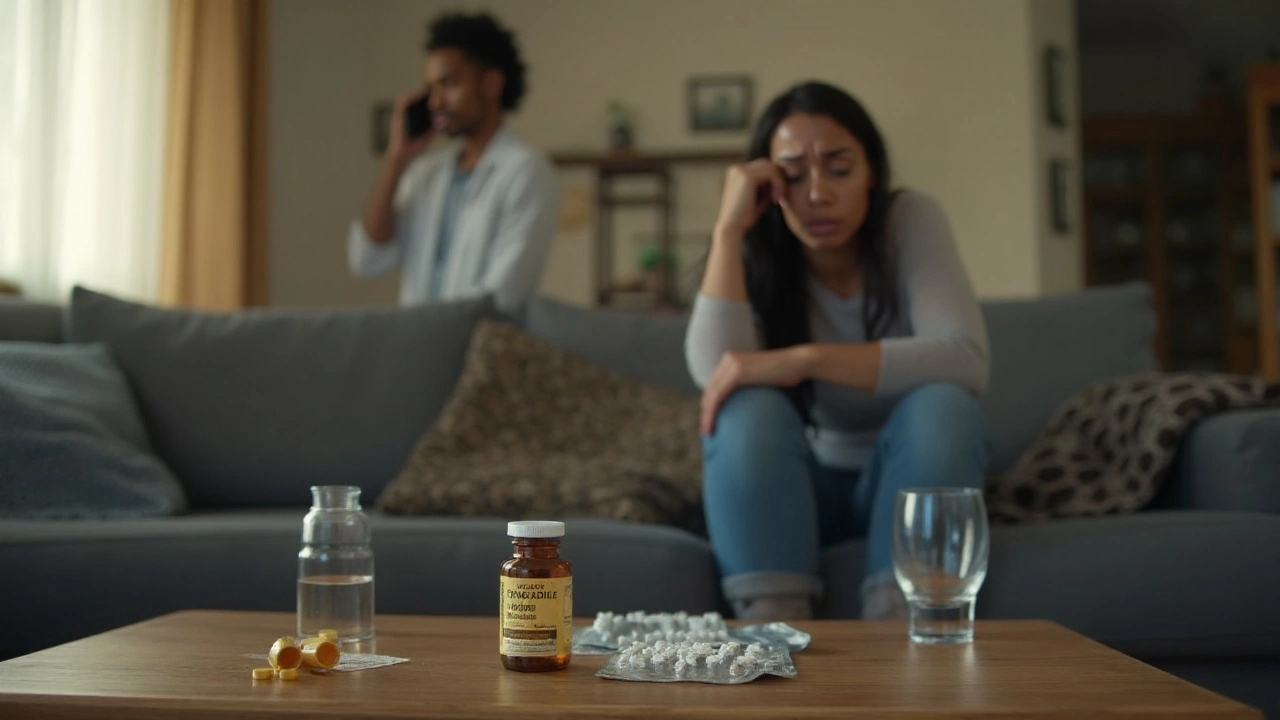When someone takes too much ornidazole-by mistake or on purpose-you don’t have hours to debate what to do. You need a plain-English plan: which symptoms matter, when to go to the emergency department, and what treatment to expect. This guide breaks it down step by step. It’s for patients, parents, and caregivers who want to act fast and avoid common mistakes. It doesn’t replace emergency care, but it will help you make safer choices in the moments that count.
TL;DR: Key takeaways on ornidazole overdose
- Red flags within hours: persistent vomiting, severe dizziness or ataxia (unsteady walking), confusion, seizures, or unusual eye/hand movements. Seek urgent care for any of these.
- Do not induce vomiting. If the person is awake and safe to swallow, activated charcoal may be used in hospital within about 2 hours of a large ingestion.
- No antidote exists. Treatment is supportive: protect airway, control seizures with benzodiazepines, IV fluids, correction of salts and blood sugar, and monitoring of liver function and nerves.
- Avoid alcohol. Nitroimidazoles can trigger a disulfiram-like reaction and worsen nausea, flushing, and blood pressure swings.
- Get professional help early. A poison centre or emergency clinician can weigh the dose, timing, and patient risks (liver disease, pregnancy, epilepsy, children).
Spotting symptoms: what happens and when
Ornidazole is a nitroimidazole antibiotic/antiprotozoal related to metronidazole. In overdose, two organ systems lead the trouble list: the gut and the brain. The drug is well absorbed by mouth, crosses the blood-brain barrier, and has a relatively long half-life (roughly 12-14 hours), so effects can build and linger (Martindale: The Complete Drug Reference, 2024; South African Medicines Formulary, 2023).
Typical timeline after a large ingestion:
- 0-2 hours: nausea, metallic taste, vomiting, abdominal pain. Headache and lightheadedness can start here.
- 2-8 hours: neurologic symptoms ramp up-marked dizziness, ataxia (wobbliness when walking), drowsiness, slurred speech, tremor. Some people develop visual changes or nystagmus (rapid eye movements).
- 4-24 hours: severe toxicity-confusion, agitation, seizures, or brief loss of consciousness. Rarely, acute encephalopathy patterns described with related drugs can appear on imaging in hospital (Micromedex Toxicology, 2025; WHO Model Formulary, 2023).
- Days to weeks (after big or repeated overdoses): peripheral neuropathy-tingling, numbness, burning in hands/feet, and sometimes unsteady gait. This usually improves slowly after stopping exposure, but recovery can take weeks (Product Information/SmPC: Ornidazole; SAMF, 2023).
Other concerns that shape urgency:
- Liver stress: transaminases can rise; jaundice is uncommon but possible in vulnerable people (pre-existing liver disease, heavy alcohol use).
- Electrolyte issues: repeated vomiting can cause low potassium or sodium, raising seizure risk.
- Alcohol: co-ingestion can provoke flushing, cramps, vomiting, and blood pressure swings-think disulfiram-like reactions with nitroimidazoles.
How much is “too much”? Adult therapeutic doses vary by indication (often 500-1,500 mg/day short term). A single unplanned multi-gram dose is concerning. In children, even one adult tablet can be risky. Exact toxic thresholds aren’t crisply defined, so decisions hinge on symptoms, dose estimate, and patient factors (SmPC/Package Insert: Ornidazole; Micromedex Toxicology, 2025).
High-risk groups to treat with a lower threshold for urgent care:
- Children under 6 years or under 20 kg
- Pregnancy (especially first trimester) and breastfeeding
- Known epilepsy or prior seizures
- Liver disease or heavy alcohol use
- Elderly, or anyone on interacting medicines (e.g., warfarin)
Quick compare to situate your expectations: ornidazole resembles metronidazole but lasts longer in the body. That longer half-life means symptoms can persist into the next day, and observation periods may be a bit longer after a big exposure (Martindale, 2024).

What to do now: step-by-step first aid
Use this if you’re with the person or you’re the one who took it. If any life-threatening symptom is present-seizure, collapsing, blue lips, severe confusion-seek emergency care immediately. Stay calm and move through the steps.
- Check responsiveness and breathing. Put the person on their side if they’re drowsy and may vomit. Clear the mouth gently if needed.
- Do not induce vomiting. Syrup of ipecac, salt water, or “home detox” hacks are harmful.
- If awake, alert, and able to swallow: offer small sips of water. Skip food and alcohol for now.
- Gather facts: time of ingestion, product name/strength, maximum possible number of tablets/capsules, any other medicines or alcohol taken. Keep the packaging.
- Call a poison centre or urgent care. In South Africa, the national poison information service can advise on home observation versus hospital. If you’re outside SA, use your country’s poison help line.
- Watch for red flags: repeated vomiting (more than 2-3 times), severe dizziness/ataxia, confusion, visual changes, tremor, muscle jerks, or any seizure activity. Any of these = go to emergency care.
- Driving is unsafe. Arrange a ride or ambulance. Keep the person supervised constantly-falls can happen fast with ataxia.
Special notes:
- Children: seek medical advice even if they look fine. Their smaller body mass makes the same pill a bigger problem.
- Pregnancy: get medical guidance immediately. Nitroimidazole exposure decisions weigh trimester and dose (WHO Model Formulary, 2023; SAMF, 2023).
- Warfarin users: bleeding risk can rise. Contact your clinician urgently; INR testing may be needed.
What not to do:
- Don’t give milk or activated charcoal at home unless a clinician tells you to. Charcoal can risk aspiration if the person vomits or becomes drowsy; it’s safest in a monitored setting.
- Don’t “sleep it off” if there are red flags. Seizures can occur without warning.
- Don’t mix with alcohol. Wait at least 48 hours after the last dose before any drinking to reduce adverse reactions (SmPC: Ornidazole).
What doctors do: tests and treatment you can expect
There’s no specific antidote for ornidazole overdose. Care is anchored in standard toxicology principles: stabilize first, decontaminate when appropriate, treat complications early, and monitor until safe.
Initial priorities (Emergency Department):
- Airway, breathing, circulation: oxygen if needed, IV line, glucose check, and rapid assessment for head injury from falls.
- ECG monitoring: mainly to screen for other co-ingestants; nitroimidazoles aren’t classic rhythm offenders.
- Labs: electrolytes (sodium, potassium), glucose, kidney function, liver enzymes, full blood count. Pregnancy test if relevant. Serum ornidazole levels are not routinely available and don’t change management (Micromedex Toxicology, 2025).
Decontamination:
- Activated charcoal (typically 1 g/kg up to ~50 g) may be considered within about 2 hours of a large ingestion if the airway is protected (awake and cooperative, or intubated). Beyond that window, benefit falls off (American College of Medical Toxicology Position Statement on Gastrointestinal Decontamination, 2023).
- Gastric lavage is rarely used and only in exceptional situations, early after a massive ingestion, with airway protection in place.
Symptom control and supportive care:
- Nausea/vomiting: ondansetron or other antiemetics; IV fluids to correct dehydration.
- Seizures: benzodiazepines are first-line. Consider second-line antiepileptics if seizures persist. Avoid bupropion, tramadol, or other pro-convulsant co-meds.
- Neurologic agitation/confusion: low-dose benzodiazepines, quiet environment, fall prevention.
- Liver monitoring: trending ALT/AST if dose was large or symptoms persist; counsel on avoiding alcohol.
- Peripheral neuropathy: usually supportive; arrange follow-up if tingling or numbness linger after discharge.
Enhanced elimination?
- Dialysis: nitroimidazoles are relatively small molecules and some are dialyzable, but clinical benefit in isolated ornidazole overdose is unproven. Dialysis isn’t routine and would be considered mainly for severe toxicity with renal failure or multiple co-ingestants, in consultation with toxicology/nephrology (Martindale, 2024; Micromedex, 2025).
Observation and discharge:
- Asymptomatic patients after modest excess doses are typically observed for 6-12 hours. Because ornidazole’s half-life is longer than metronidazole, clinicians may extend observation if symptoms are evolving.
- Discharge requires stable vitals, normal mentation, controlled nausea, safe walking, and support at home. Written safety advice and follow-up instructions are key.
Documentation and mental health: if the overdose was intentional, compassionate mental health assessment and safety planning are part of gold-standard care in South Africa and worldwide.
Evidence base referenced by clinicians includes the product label (SmPC), toxicology databases (Micromedex), pharmacology texts (Goodman & Gilman; Martindale), and local formularies (SAMF; WHO Model Formulary). These sources consistently describe overdose management as supportive, with particular attention to neurologic effects and potential for sensory neuropathies.

Prevention, interactions, checklists, and your follow-up questions
Prevention is not glamorous, but it’s how you avoid late-night panic. Keep these rules tight at home.
Safe-use checklist for ornidazole:
- One person, one box. Don’t mix different dosages in the same pill container.
- Use a pill organizer or set an alarm to avoid double-dosing.
- Never take “extra to catch up.” If you miss a dose, take it when you remember unless it’s near the next dose; then skip. No doubling.
- Avoid alcohol during treatment and for at least 48 hours after the last dose.
- Tell your clinician if you have liver disease, are pregnant/breastfeeding, or have a history of seizures.
- Store medicines locked and up high; original blister packs deter curious fingers.
Interactions and special cautions:
- Alcohol: risk of flushing, cramps, vomiting, and blood pressure changes-skip it.
- Warfarin and similar anticoagulants: nitroimidazoles can raise INR and bleeding risk; extra monitoring may be needed (SAMF, 2023).
- Disulfiram: potential for confusion and psychosis-like reactions with nitroimidazoles-avoid concurrent use (WHO Model Formulary, 2023).
- Enzyme-modifying drugs (e.g., certain antiepileptics): may alter levels; your prescriber will adjust if necessary.
- Liver disease: slower clearance raises toxicity risk-dosing adjustments and closer monitoring apply.
How ornidazole stacks up against metronidazole (for overdose-relevant points):
| Property | Ornidazole | Metronidazole |
|---|---|---|
| Class | Nitroimidazole | Nitroimidazole |
| Half-life (adult) | ~12-14 hours | ~6-8 hours |
| Key overdose features | GI upset, dizziness/ataxia, seizures, peripheral neuropathy | Similar; encephalopathy reported in rare cases |
| Dialysis relevance | Not routine; limited benefit expected | Can be removed; not standard unless special circumstances |
| Alcohol reaction risk | Yes-avoid | Yes-avoid |
Mini‑FAQ
- Is there an antidote? No. Management is supportive-airway protection, seizure control, fluids, and monitoring (SmPC; Micromedex, 2025).
- How much is dangerous? There’s no universal cut-off. Any multi‑gram single dose, unknown dose in a child, or symptoms like severe dizziness, confusion, or seizures deserve urgent care.
- Can I just wait at home? If you’re symptom‑free after a small extra dose and you’ve spoken with a professional who agrees, home observation with a trusted adult may be okay. Any red flag symptom means go in.
- Can I take it with alcohol? No. Avoid alcohol during therapy and for 48 hours afterward due to disulfiram‑like reactions.
- Will I need scans or a spinal tap? Almost never. Imaging is reserved for unusual or severe neurologic findings to rule out other causes.
- How long until I feel normal? Mild GI symptoms can settle within a day. Neurologic symptoms can take 24-72 hours; lingering tingling may last weeks if nerves were irritated.
- Should I stop my course after an overdose? Don’t self‑decide. A clinician may restart later at a proper dose or switch you to an alternative, depending on why you were taking ornidazole.
Decision rules you can use tonight:
- No symptoms + small, known extra dose + adult without risk factors: call for advice; home watch with a responsible adult may be enough.
- Any neurologic symptom (ataxia, confusion, visual changes), repeated vomiting, unknown dose, child, pregnancy, or liver disease: get urgent in‑person evaluation.
- Any seizure, fainting, blue lips, or severe agitation: emergency care now.
Next steps and troubleshooting
- I took an extra dose by mistake, feel okay: note time/dose, skip the next scheduled dose, and contact your prescriber or a poison centre for individualized advice.
- I drank alcohol with my dose: stop drinking, hydrate, and seek medical advice if flushing, vomiting, dizziness, or chest discomfort occurs.
- My child may have swallowed a tablet: assume ingestion until proven otherwise. Seek guidance from a poison centre or clinic immediately and bring the packaging.
- I’m on warfarin: call your clinician promptly to plan INR monitoring and watch for bleeding (bruises, nosebleeds, dark stools).
- Symptoms started the next day: because of the longer half‑life, delayed or persistent dizziness/tingling can happen-get assessed, especially if balance is off.
Why you can trust this guidance: the actions above align with the ornidazole product label (SmPC/Package Insert), the South African Medicines Formulary (2023), WHO Model Formulary (2023), Micromedex Toxicology (2025), ACMT guidance on decontamination (2023), and standard pharmacology texts that clinicians use in emergency and toxicology settings.
Final gentle reminder: if you’re in South Africa, the Poison Information Helpline can advise 24/7. Wherever you are, your local poison centre and emergency department are your best safety net. Bring the medication box, be honest about timing and dose, and don’t drive yourself if you feel unsteady.
